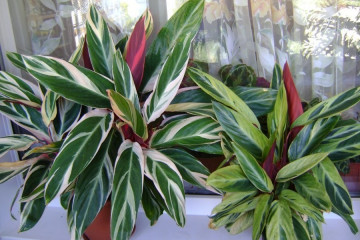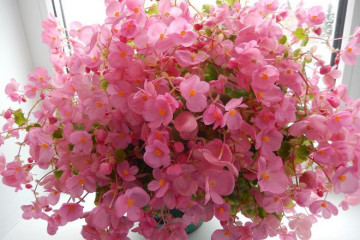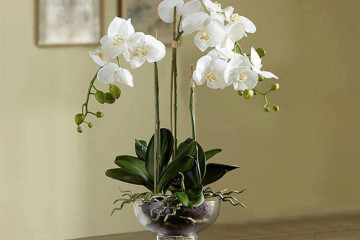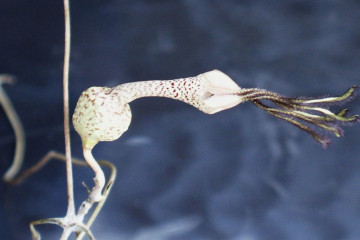Myrtle - home care, how to reanimate if it has dried up
Content:
Myrtle is a fragrant plant that is suitable for cultivation in homes. It takes care, but caring for a myrtle tree at home is not as tedious as many people think. The tree is able to delight florists for many years with its original appearance and fragrance.
Origin and appearance
The genus Myrtus includes about 110 species of shrubs or small trees. Small forms of Myrtus communis have proven their value when grown as domestic crops.
In combination with other indoor plants, the tree looks very organic. It is noticed that it can have a calming effect on the nervous system. In various parts of the world, since ancient times, the plant has embodied love, peace, harmony, beauty and youth. The presence of myrtle in the wedding room among European nations creates a special aura and is a sign of a successful marriage and family happiness.
The natural habitat of the evergreen myrtle tree is the subtropical regions of the Mediterranean, other varieties grow in Australia, Asia, America. In its homeland, myrtle reaches a height of 5 m, if grown indoors, it rarely exceeds 60 cm. The main external signs of a plant:
- leaves are small, glossy and dense, ovoid, slightly pointed;
- flowers are white and pinkish, in their composition, as in the leaves, a high content of essential oils;
- fruits - berries of dark blue color, there are also other colors.
The originality of the plant, the ability to decorate any interior attracts florists. In addition to external expressiveness, myrtle has the following advantages:
- essential oils contain volatile substances that have antimicrobial, antibacterial effect, allergy symptoms may decrease or disappear from their healing effect;
- decoctions and infusions for skin care can be made from leaves and flowers;
- dried berries and leaves will serve as a spice in cooking.
Bloom
The myrtle tree begins to bloom in May, exuding a pleasant aroma. Some species finish flowering in September. The flowers are medium-sized, do not exceed 2 cm in diameter, appear in large numbers, up to 50 pieces per plant, on single pedicels in the leaf axils. Color from white to cream and pink. Numerous long stamens give the flowers a fluffy appearance.
Types and varieties
Of the existing varieties, the common myrtle, or Myrtus communis, is the most commonly used houseplant. It is characterized by compact shape, fast growth, high decorative effect. The trunk of the tree is covered with bark in the form of scales, which can flake off. Leaves are oval, dense, glossy. White flowers have a large number of long stamens.
Breeders have developed several hybrid varieties. The most popular ones are:
- Tarentine.A dwarf variety of common myrtle. The elongated leaves are limited in size to 1.5 centimeters. Blooms in groups of small flowers. Differs in accelerated growth;
- Alhambra. The plant has small, dense leaves with a lot of essential oils. Numerous flowers have a slightly pinkish tint at the beginning of flowering. The fruits are white in color;
- Variegata, with unusual color of leaves. Their main color is dark green. There is a gold border along the edge, light spots are possible in other places of the leaves;
- La Clape. Differs in purple fruits;
- Microphylla. Possesses compact forms, the height does not exceed 60 cm. Small-leaved variety with a dense crown. Young leaves are bright, darken with age.
Pot transplant
The plant is considered quite capricious, intolerant of stress, travel, temperature extremes. So that the tree does not die when the living conditions change, it is necessary to follow four rules for caring for myrtle:
- Do not replant immediately after purchase. It is necessary to wait for the plant to adapt. A quick transplant often leads to the fact that the leaves begin to fall off, and the myrtle perishes;
- Increase humidity. If the tree looks weak, the leaves are sluggish, some stems are bare, you can cover it with a transparent plastic bag, creating a greenhouse effect. The package is removed for a short period of time every day. In greenhouse conditions, myrtle lasts up to 1 month;
- Keep in partial shade. For the period of adaptation, the myrtle is placed in partial shade, protected from direct sunlight;
- Avoid drafts. Even a healthy adult bush reacts negatively to drafts; in the case of a newly acquired young plant, this is unacceptable.
What is needed for landing
Until the age of three, myrtle is transplanted annually, each time slightly increasing the volume of the flower container. Adults only need one transplant every 3-4 years.
Features:
- The soil should be loose, light, moderately nutritious. A versatile flower potting soil mix with chopped peat and coarse sand is suitable;
- The size of the pot is chosen slightly larger than the root system, the shape is similar to the previous container in terms of the ratio of width and height. It is checked that drainage holes are visible at the bottom;
- As a drainage, it is necessary to prepare small pebbles, brick or ceramic chips.
Optimal location
In the post-transplant period, the myrtle should be placed in a relatively shady and cool place. However, when the plant has already adapted, it can be moved to a permanent location, the choice of which should be approached taking into account the following recommendations:
- The myrtle tree loves well-lit surfaces, but does not tolerate heat well, so it is desirable that diffused sunlight falls on it.
- The plant does not like a sharp change in habitat, it must be moved gradually.
- The southwestern and southeastern sides of a house or apartment are optimal places for a tree to live, since in the north the plant rest period is lengthened, its growth is inhibited, flowering may not occur.
Landing procedure
The step-by-step procedure for planting myrtle includes the following steps:
- Prepare everything you need: soil, pot, drainage, after sterilizing them;
- Achieve drying of the soil. The plant should be slightly dehydrated before transplanting. So it can be pulled out of the previous container without any problems;
- Create a drainage layer in a new pot, it should be a third of the volume, fill half the pot with soil;
- Cleansing an earthen coma with roots. It is convenient to gently straighten the roots with a wooden stick.Cleansing is carried out only at the edges;
- Root processing. If there are dry or rotten roots, they are removed by treating the sections with coal dust and "Kornevin";
- Gently place the bush in the middle of the pot with soil, sprinkle the roots, gently pressing with your fingers.
For early adaptation to the new pot, the tree is immediately watered and sprayed. Then it remains in partial shade for about a week with regular spraying. Irrigation with a solution of a weak growth stimulator "Epin" will be useful. When new shoots appear, the myrtle is moved to a permanent habitat.
Reproduction of myrtle indoors
There are two ways to propagate myrtle: seeds and cuttings. To use any of them, you need to be patient and make some effort. Experienced florists prefer to reproduce myrtle in the second way.
Cuttings
The technology of this method is not very complicated and includes the following steps:
- The procedure is performed twice a year: in the middle of winter and in the middle of summer. At other times, it will be very difficult to root the sprouts;
- Cuttings must be cut from the middle of the plant, their length is 6-8 cm;
- The leaves are removed at the bottom or shortened a little, which will not lose moisture;
- The lower part of the cuttings, placed in the ground, is treated with a growth stimulant.
- The substrate for cuttings consists of a mixture of moss and sand, but the soil layer is also suitable for it. Planting depth - 30 mm;
- The seedlings need to be provided with shade, temperatures from + 15 ° to + 20 ° C and high humidity, for which each of them can be covered, for example, with a plastic cup. If the ambient temperature is high, the cup is removed every day for 10-15 minutes for air access.
- Roots should appear within 1 month, then the plant is ready for planting in the soil.
If you follow these simple rules of cuttings, young plants will bloom within 3-4 years.
Growing from seeds
Florists also know how myrtle reproduces from seeds, but this is time consuming and troublesome, so the method is rarely used.
Technology, how to grow myrtle from seeds:
- The seeds are soaked in a weak solution of potassium permanganate for 1.5-2 hours;
- For planting, a substrate is prepared from a mixture of peat and sand, it should be light and breathable. It is recommended to pre-calcine the sand in a pan;
- To plant seeds and moisten crops, it is good to use sprayers for this. Seed the soil should be close to its surface, no deeper than 5 mm;
- Cover the container with plastic wrap and place in a bright, warm room. Periodically lift the cover for ventilation;
- Remove the film only after germination. This will happen in about 1.5-2 months;
- The grown seedlings are transplanted into separate containers;
- When the shoots reach 15 cm, at least 2 leaves have already been released, the top (growth point) is pinched to stimulate the lateral development of the future bush.
If the myrtle is grown from seed, flowering occurs in the fifth year.
The fact that the fruits are set with the formation of seeds must be taken care of during flowering by artificial pollination.
Myrtle care
If you decide to start a myrtle, caring for it at home has a number of features, non-observance of which can lead to poor tree growth, lack of flowering, and even death.
Pruning
Standard myrtle is available for purchase at retail outlets, that is, with an even trunk, free of branches from below. If the plant is not pruned periodically, it grows like a pyramidal bush.It is possible to form a dense dense crown of a spherical shape when trimming the tips of branches (shoots). This also helps to strengthen them.
Watering mode
The plant needs high humidity, so good watering is ensured during the period of activity. If there is too little water, the tree begins to shed its foliage. The soil in the pot should always be slightly damp. Myrtle reacts well to regular spraying and a warm shower. However, over-watering can lead to root rot, so good drainage is important.
Top dressing
Regular feeding leads to the fact that the myrtle will grow faster and bloom more abundantly. It is good to use complex fertilizers for plants, but preparations containing calcium should be avoided. The frequency of feeding is once a week or two.
Flowering period
If you take proper care of myrtle, it will surely give abundant flowering. Possible reasons for the absence of flower ovaries:
- low humidity;
- a sharp change in the habitat of a plant, for example, an unexpected transfer from partial shade to open light;
- pruning the crown in the spring will provide enhanced growth of young shoots, but exclude the appearance of flowers, therefore, the procedure should be performed in winter or immediately after flowering;
- irregular fertilization;
- the presence of diseases or pests.
Dormant period
In winter, the need for watering should be controlled by the condition of the soil. If it is dry by 1-2 cm in depth, then watering is performed.
Also, during the rest period, the frequency of feeding should be reduced: no more than once every 1.5 months.
During the rest period, spraying can be stopped, but if there are elements of central heating in the room, the plant should be protected from them by creating a protective barrier.
In winter, myrtle does not tolerate high air temperatures. Ideal conditions for it are from + 8 ° to + 10 ° С. Otherwise, summer bloom may not come.
Preparing for winter
- If the house has a warm balcony or loggia, it is better to move the plant to a place where it will be away from heating appliances and with sufficient light. In the absence of such a place, the use of air humidifiers next to the myrtle tree gives a good effect;
- It is necessary to provide maximum sunlight exposure;
- Exclude transplanting and pruning;
- Protect from drafts.
It is especially difficult to provide optimal conditions for myrtle in winter in a city apartment. The first signs of a dysfunctional plant condition - the leaves begin to dry and curl. If, after all, the myrtle has dried up, how to reanimate it?
Resuscitation interventions are often beneficial. The plant is carefully examined. If the branches remain firm, there is a chance to revive the myrtle. First, the tree is bathed under a warm shower, watered abundantly and sprayed with Epin. Then put on a plastic bag on top, put in a shaded place. The bag is removed daily, the plant is well sprayed. The procedure is repeated throughout the week.
If a tree begins to die from an overdose of fertilizers, then the way to reanimate it is to transplant it into another soil, but it is not always possible to achieve the desired effect.
Myrtle grows well in a sunny apartment or office. If you follow the rules of care, then the tree will delight you with its healthy and beautiful appearance for a long time, its useful properties will serve as a pleasant bonus.




























